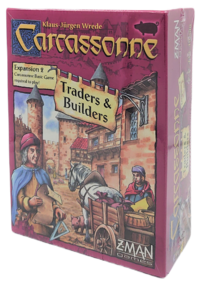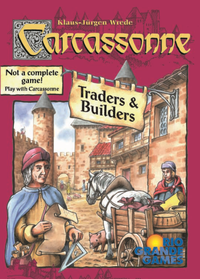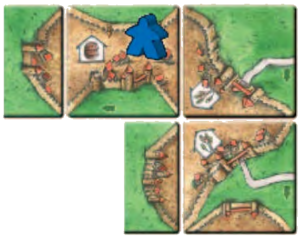Traders and Builders (1st edition)
 |
You are reading the rules for this tile design. |
 | Read the following rules if your tiles look like this. |  |
| If your tiles have a different design, then choose a game from Spin-offs. |  |
Z-Man Games |
Rio Grande Games |
General info and comments
Traders and Builders was originally released by Hans im Glück in 2003.
This is the second major expansion for Carcassonne and introduces a few new aspects to the game. They introduced some new tiles that brought new things with them.
New features/things are:
- Trade Good Tokens
- Pigs
- Builders
A Carcassonne expansion is not really a Carcassonne expansion when there are no new tiles, so in the box you also find 24 tiles that represent cities, roads and cloisters in new shapes to help create a much more beautiful landscape. The tiles of the first German editions had no expansion symbol.
Contents
- 24 Land Tiles (9 Wine, 6 Grain, 5 Cloth, 4 w/o Goods)
- 20 Trade Good Tokens (9 Wine, 6 Grain, 5 Cloth) [1]
- 6 Builder Figures (1 x 6 Colors) [2]
- 6 Pig Figures (1 x 6 Colors) [2]
- 1 Cloth Bag [3]
- Rules Sheet
Rules
Preparation
The 24 tiles should be mixed with the rest of the tiles.
Place a tile
The new land tiles are placed in the usual way. Take care with the following tiles: [4]
The bridge is not a crossing. One road runs continuously from left to right, while the other runs from top to bottom. However, the field segments are separate. The tile has four separate field segments.
One road ends at a city, the other at a house. The tile has three separate field segments.
The cloister divides the road into three segments.
This tile has three separate city segments.
Deploy a follower
Instead of deploying a normal or big follower, a player may now decide to deploy their builder or pig. These are deployed according the following rules.
The builder
Deployment: The builder can only be deployed to the tile which has just been placed, and then only to a road or city which already includes one of the player's followers. As such, the player must first deploy a follower to a road or city as usual, place a tile which extends this road or city in a subsequent turn, and then deploy a builder to the tile.
- A builder can be deployed even if there are thieves, knights, or builders of other players on the road or city.
- It does not matter how many tiles there are between the builder and the thief or knight.
- A builder may be deployed to a road or to a city, as the player wishes.
- A builder may never be deployed to a farm.
Effect: Whenever the player places a tile that extends [5] [6] [7] the road or city which includes their builder, they may take a double turn. [8] [9] Here, after performing the usual steps of deployment and scoring, [10] the player draws another land tile, places it appropriately, and may then deploy another follower and carry out any necessary scoring. [11]
The player’s turn is then over.
Important notes regarding use of the builder and the double turn:
- There is no chain reaction. If the play continues the road or city which includes their builder, they may not draw a third tile.
- If the road or city is not completed during the course of either part of the double turn, the builder remains in play. The player may generate a double turn on each subsequent turn as well, as long as the road or city containing the builder remains incomplete. If it is completed, the builder and thief or knight are returned to the player after it has been scored.
- The player can deploy a follower to the second tile as well as to the first. If the road or city is completed by the placement of the first tile, then the player may deploy the newly-returned builder to the second tile.
- The builder is not counted when calculating the majority. [12]
- When a player’s last thief or knight is removed from a road or city with a builder, the player takes his builder, putting it in his supply. [13]
The pig
Deployment: The pig can only be deployed to the tile which has just been placed, and then only to a farm which already contains one of the player's farmers.
- There can already be farmers or pigs of other players on the farm.
Effect: The pig increases the value of cities for the farmers.
- During the final scoring, a player with his or her pig on a farm scores 4 rather than 3 points for every city on that farm. [14] This is true only when the owner of the pig has a majority on the farm (or is in a tie for the majority); if a player does not earn points for a city, the pig adds nothing. As before, only farmers determine ownership of a farm.
- The pig does not count when calculating the majority. [15]
- If the last farmer of the owner of the pig is removed from the farm with the pig, then the pig is also returned to the player. [16] Otherwise the pig remains on the farm to which it was deployed until the end of the game.
Scoring
A city with trade goods is completed
When a city containing one or more trade symbols is completed, the city is scored as usual. The player who completed the city receives one trade counter for each related trade symbol in the city - this player is, so to speak, the trader of the city. It is irrelevant whether this player had a knight in the city, or indeed whether there were any knights in the city at all. [17]
Final Scoring [18]
Trade Counters
The player who has collected the most wine counters scores 10 points. The same is true for the player with the most grain counters and the most cloth counters. As usual, in the case of a draw all players involved score the full 10 points.
Pigs on a farm
A player with his or her pig on a farm scores 4 rather than 3 points for every completed city.
The Double Turn
Things That Happen Only ONCE
- Bonus point from Fairy (The Princess and the Dragon)
- Prisoner Buyback (3 points) (The Tower)
- Tunnel token placement (The Tunnel)
- Flight from Plague (The Plague)
- Plague spread (The Plague)
Things That May or Must Happen TWICE
- Draw and place a landscape tile (required)
- Resolution of special symbols on tile (required)
- Follower, figure or token placement
- Scoring (if one or more features are completed)
- Prisoner exchange (can be more than twice) (The Tower)
- Removal of a knight from a besieged city
House Rules
Players are allowed to keep drawing additional tiles as long as they extend their city/road where their builder is deployed. (Thanks to Diminuendo)
To bring the trade goods in line with the relative scoring of the King and Robber Baron (Count, King and Robber), a player with a majority no longer scores 10 points. Instead, they receive a 10% bonus (or 10 points, whichever is higher) to their total score at the end of the game, after calculating farms and incomplete features, but before calculating any other scores such as those from the King and Robber Baron. Additionally, any player who does not win the majority may be awarded 2 points for every token they own. (Thanks to kissybooboo)
Tile distribution
Footnotes
For Icons explanation and licensing please visit Icons page.
- ↑
 The bag is not included in the Big Box set, and so is omitted from the list. The original explanation for the use of the bag is as follows: ‘For technical reasons, the tiles of Carcassonne (the basic game) and the expansion(s) may have slightly different colors. Should this be the case, the tiles may be drawn from the bag.’
The bag is not included in the Big Box set, and so is omitted from the list. The original explanation for the use of the bag is as follows: ‘For technical reasons, the tiles of Carcassonne (the basic game) and the expansion(s) may have slightly different colors. Should this be the case, the tiles may be drawn from the bag.’
- ↑ 2.0 2.1
 The original rules say: ‘12 new followers in 6 colors (one builder and one pig for each player)’. In the Big Box rules, the builder and pig are no longer considered to be followers, which has a large number of consequences for their use. The RGG edition of the Big Box also changes this rule.
The original rules say: ‘12 new followers in 6 colors (one builder and one pig for each player)’. In the Big Box rules, the builder and pig are no longer considered to be followers, which has a large number of consequences for their use. The RGG edition of the Big Box also changes this rule.
- ↑
 Not all versions come with a cloth bag.
Not all versions come with a cloth bag.
- ↑
 Notice that on the second tile, the road ends in a house; not an inn (there is no lake).
Notice that on the second tile, the road ends in a house; not an inn (there is no lake).
- ↑
 This is a change from the original rules, which stated that the tile must “complete or extend” the feature. The abbey tile from Abbey and the Mayor completes but does not extend a feature. The RGG edition of the Big Box also changes this rule.
This is a change from the original rules, which stated that the tile must “complete or extend” the feature. The abbey tile from Abbey and the Mayor completes but does not extend a feature. The RGG edition of the Big Box also changes this rule.
- ↑
 If a player completes a feature with an Abbey tile and his or her builder is on the feature, the feature does not get “extended” by the Abbey (as the Abbey is a separate feature), so the player does not get another tile.
If a player completes a feature with an Abbey tile and his or her builder is on the feature, the feature does not get “extended” by the Abbey (as the Abbey is a separate feature), so the player does not get another tile.
- ↑
 Placing a bridge on a tile to extend a road is sufficient to trigger the builder’s double turn, as is placement of a tunnel marker if additional tile(s) become part of the road in question.
Placing a bridge on a tile to extend a road is sufficient to trigger the builder’s double turn, as is placement of a tunnel marker if additional tile(s) become part of the road in question.
- ↑
 The original rules say that “the builder makes the double turn possible.” Given the use of the word “may,” or that the player “is allowed” to take a double turn in the RGG rules, it seems that the double turn is optional (though there are likely few circumstances where one would choose not to take the double turn).
The original rules say that “the builder makes the double turn possible.” Given the use of the word “may,” or that the player “is allowed” to take a double turn in the RGG rules, it seems that the double turn is optional (though there are likely few circumstances where one would choose not to take the double turn).
- ↑
 As long as the builder was present in the city/road when the tile was placed to extend it, the second part of the builder turn can occur even if the builder is no longer present by the end of the first part of the turn (such as removal by completing the city, or removal by the dragon, or removal by The Festival). (3/2015; updated 12/2018)
As long as the builder was present in the city/road when the tile was placed to extend it, the second part of the builder turn can occur even if the builder is no longer present by the end of the first part of the turn (such as removal by completing the city, or removal by the dragon, or removal by The Festival). (3/2015; updated 12/2018)
- ↑
 Originally the rules stated that the second tile was drawn (and placed) “immediately”; the Big Box rules state that the tile is drawn “after the usual steps of deployment and scoring have been performed.” The first part of the player’s turn should be completed in its entirety before beginning the second part of the double turn by taking a second tile.
Originally the rules stated that the second tile was drawn (and placed) “immediately”; the Big Box rules state that the tile is drawn “after the usual steps of deployment and scoring have been performed.” The first part of the player’s turn should be completed in its entirety before beginning the second part of the double turn by taking a second tile.
- ↑
 Important note: The "double turn" is really a single turn with two parts. Both parts of the double-turn are identical, but actions that only occur once per turn (such as fairy bonus point and prisoner buy-back) still only happen once. See #The Double Turn section/table for more details. (modified 6/2013)
Important note: The "double turn" is really a single turn with two parts. Both parts of the double-turn are identical, but actions that only occur once per turn (such as fairy bonus point and prisoner buy-back) still only happen once. See #The Double Turn section/table for more details. (modified 6/2013)
- ↑
 As noted above, the builder is no longer considered to be a follower, so it does not count when calculating the majority.
As noted above, the builder is no longer considered to be a follower, so it does not count when calculating the majority.
- ↑
 In the RGG version of the Big Box, this rule is included in The Princess and the Dragon section.
In the RGG version of the Big Box, this rule is included in The Princess and the Dragon section.
- ↑
 According to third edition rules for scoring farms.
According to third edition rules for scoring farms.
- ↑
 The pig is no longer a follower, so it does not count when calculating the majority.
The pig is no longer a follower, so it does not count when calculating the majority.
- ↑
 This is a consequence of the rule that builders and pigs are not followers, and it also applies when the last thief or knight is removed from a road or city which includes the builder. Under the old rules, the builder or pig remained in play, and the builder continued to generate double-turns. Under the current rules, the builder and pig are dependent on followers for deployment, and cannot remain in play without them.
This is a consequence of the rule that builders and pigs are not followers, and it also applies when the last thief or knight is removed from a road or city which includes the builder. Under the old rules, the builder or pig remained in play, and the builder continued to generate double-turns. Under the current rules, the builder and pig are dependent on followers for deployment, and cannot remain in play without them.
- ↑
 Question: If cities with trade goods are completed by placement of an abbey tile (Abbey and the Mayor) , are the goods tokens awarded as usual to the player placing the abbey tile? Answer: Yes, as the player completed the city.
Question: If cities with trade goods are completed by placement of an abbey tile (Abbey and the Mayor) , are the goods tokens awarded as usual to the player placing the abbey tile? Answer: Yes, as the player completed the city.
- ↑
 The example of pig scoring has been corrected - the Big Box version originally had the red follower standing.
The example of pig scoring has been corrected - the Big Box version originally had the red follower standing.









































